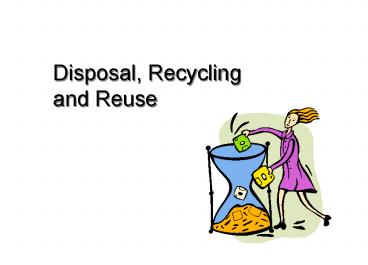Arnould PowerPoint PPT Presentation
1 / 15
Title: Arnould
1
Chapter
19
Disposal, Recycling and Reuse
2
Objectives
- Understand that disposition is a growth industry
that provides many marketing opportunities - Recognize that product disposition is an
increasingly important area for public policy - Explain the differences between voluntary and
involuntary disposition - Describe the social, individual and situational
factors that affect disposition choices - Realize how understanding disposition provides
key insights into consumption behavior
3
Why be Interested in Disposition?
- Consumers care
- Disposition is a growth industry providing many
marketing opportunities - Disposition is an important area for policy
activity - Who pays?
- Toxic dumping
- Consumer welfare
- Disposition provides insight into consumption
behaviors that have practical implications for
managers
4
Disposition
- Encompasses all those behaviors that consuming
units undertake to divest themselves of undesired
goods and services. - Green approach minimizing the need for
disposition - deconsumption and voluntary simplicity
- consuming less
5
Disposition
- Voluntary vs. involuntary disposition
- Some products may be difficult to divest because
of attachment - spatial or physical
- emotional
6
The Disposition Process
- Disposition is more like a process than an event
- Physical and emotional disposition processes
often take place in stages consumers often
desire to place unwanted items in storage for a
time to reduce their emotional connections - Factors affecting the disposition process
- Product characteristics
- Situational factors finances, storage space,
fashion change, etc. - Life status change e.g., marriage, aging, etc.
7
Profiles of Disposition Behaviors
- Discard it Abandon, etc.
- Sell it
- Swap meets informal markets to buy or trade
used goods - Electronic flea markets Internet auction sites
- Donate it
- Gift it
- e.g., Preinheritance living bequests of
household resources - Store it
- time-marked goods help people tell their life
stories - Recover it
- close-loop manufacturing recycling is built
into products from the design phase on
8
Solid Waste Generation
9
U.S. Landfill Contents 1990 Myth and Reality
Source Rathje and Murphy 1992, p. 106
10
Historical and Cross-Cultural Perspectives on
Disposition
- Garbage was often left where it lay in human
dwellings with layers of new flooring
occasionally laid over the waste. - In ancient times, pottery was equivalent of
modern containers made of glass or plastic it
was extensively recycled. - In the late Middle Ages in Europe, failure to
deal with urban solid-waste disposal led to the
Black Plague.
11
Disposition Trends
- Corporate move from concern about pollution to
waste prevention because it is profitable. - Product stewardship focuses on minimizing all
environmental impacts of a product over its
biography. - Design for Environment(DFE) a product
stewardship tool for creating products that are
easier to recover, reuse, or recycle. - Companies looking to develop clean technologies.
- Companies considering sustainable development and
marketing. (Donald Fuller) - marketing plans should be constructed so that
they are compatible with ecosystems. - Marketing plans should be constructed so that
they consider social impacts - Backward channels of distribution are increasing
in importance
12
Disposition Chains
- Simple Reuse
- Occurs when a product is reused by the consumer
for its original purpose or for a different
purpose - Secondhand Reuse (lateral recycling)
- Occurs when a product is given away as a gift or
through inheritance to friends, family or
strangers or sold to another household or traded
for another product - Secondhand Trade
- Takes place when ownership for the used products
is first transferred to an intermediary before
distribution to new users. - Resource Recovery (recycling)
- Takes place when the product or its parts are
used as a secondary resource in the production of
new products.
13
Re-manufacturing
http//www.sorbilite.com/Home.php
14
Disposition Segmentation and Psychographic
Factors
- Some people may be more inclined to recycle good
than others - Green segments
- In general, we are a throw away society
- However, a segment of the market views one
persons trash as another persons treasure - Challenge for marketers it to make green needs
more salient - Prisoners dilemma everyone benefits if all
comply but if one person doesnt comply, his/her
immediate benefits may outweigh the general good
15
Topic Takeaways
- Businesses need to be concerned with the
by-products of their production process, if for
no other reason consumers care - Solutions to consumption and over-consumption
problems will have to be developed by considering
the joint concerns of business, policy makers,
society, and individual consumers - Disposition is a process (as opposed to an
event), that (1) occurs in a variety of ways and
(2) is affected by product, situation, and person
factors - The entire value chain and biography of products
should be examined for business opportunities and
environmental and societal benefits

